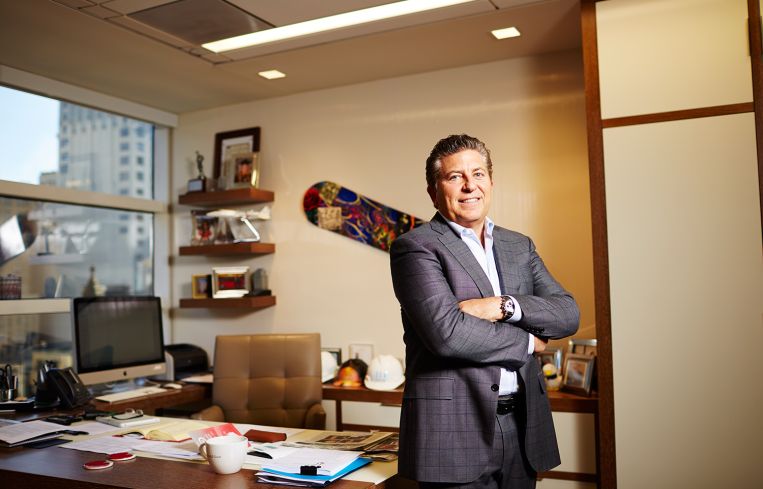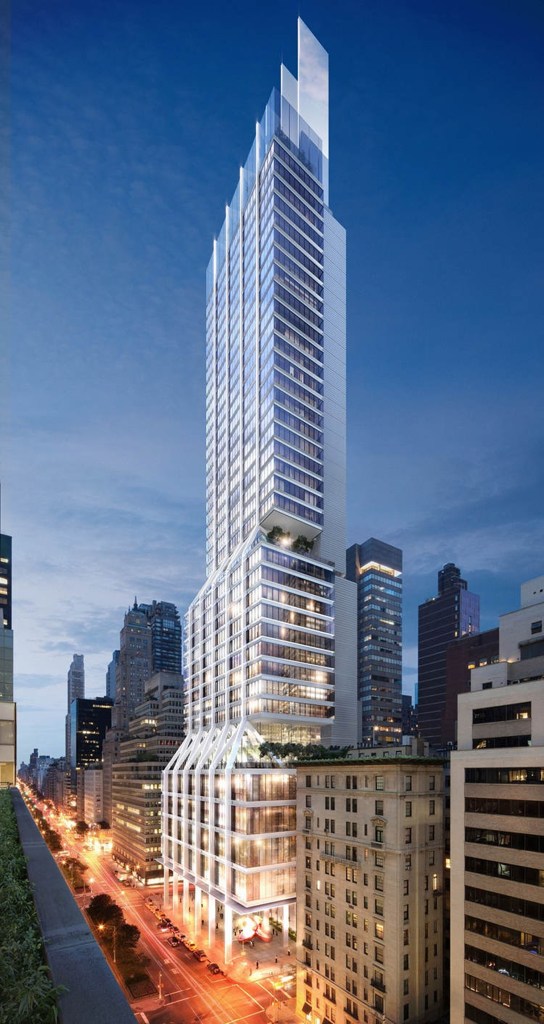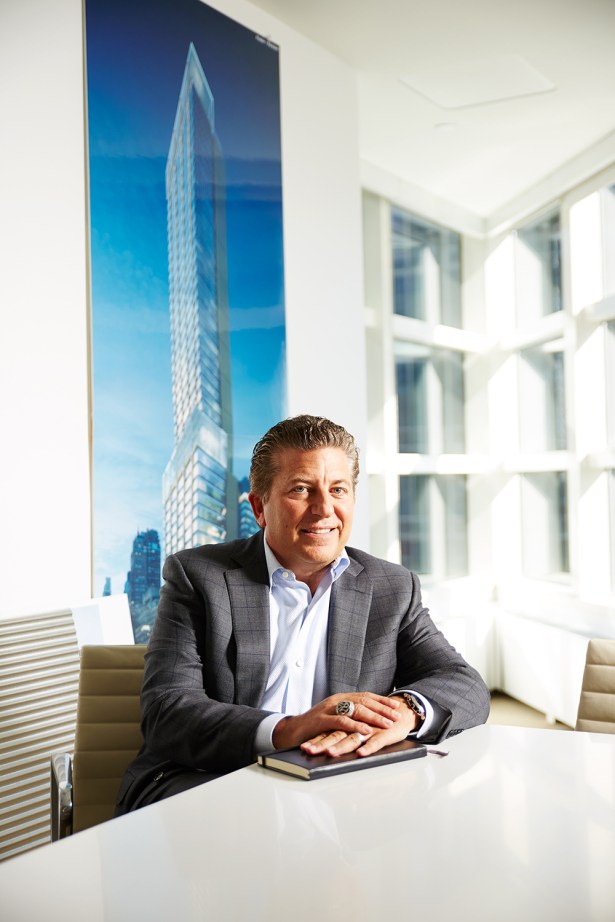L&L’s Robert Lapidus Has Just Three Numbers for Park Avenue: 4, 2, 5.
By Terence Cullen March 30, 2016 9:45 am
reprints
The typical Park Avenue face-lift is usually an outpatient procedure performed in one of the many esteemed plastic surgeon offices that dot the avenue. But Robert Lapidus, the president and chief investment officer of L&L Holding Company, has a different idea.
L&L is on a renovation tear, and one of the properties going under the knife is 425 Park Avenue between East 55th and East 56th Streets. It will go from a shorter, squatter structure to a taller, skinnier building with about roughly the same square footage. (This is the catch of building in zoning-constricted Midtown East and billing it as the first new block-front structure on the street in half a century: Developers have to allow for tall and skinny.) The Norman Foster-designed office tower has successfully made a play to persuade Chicago-based hedge fund Citadel to move its New York offices there when it’s done by 2018. Asking rent in the deal was a record-breaking $300 per square foot.
The Midtown West-based company, which has a 6-million-square-foot portfolio across 11 Manhattan buildings, is employing a similar method at 390 Madison Avenue (formerly known as 380 Madison Avenue), where it is stripping the hulky 1980s look, creating double-height retail levels and adding eight floors to the top of the building.
When Commercial Observer sat down with Mr. Lapidus, 55, at the company’s office at 142 West 57th Street last week, he discussed some of L&L’s plans throughout the city, his friendship with David Levinson, the chairman and chief executive officer of L&L, and his affection for the Grateful Dead (he has a snowboard with photos of the band on the wall behind his desk and is seeing the remaining members in concert several times this summer). We also tried our best to pry into the secret of how much of the New York Yankees he and Mr. Levinson own, which they treat like a state secret.
Commercial Observer: What are some of your responsibilities at the company?
Mr. Lapidus: David and I started the business about 16 years ago and we jointly run the company. I spend more time in the capital raising, deal structuring, acquisitions and partner relations types of things. David’s a visionary, so he spends a lot of time on the concept of the buildings and the design, as well as overseeing leasing and marketing and those types of things. But we make all major decisions jointly. We divide and conquer.
So you guys recently signed Citadel to 425 Park, correct?
4-2-5 Park. Norman Foster started saying 4-2-5 Park, and we thought it sounded better. We get to charge more rent by saying that.

It set a record, right?
It did set a record, but it’s a very special building. It really is a bespoke office building that caters to a very narrow segment of the marketplace: Those tenants who really can pay the highest rents because of the structure of their businesses. A hedge fund that has 100 people—it’s managing $30 billion—can afford those types of rents. It’s the first new block-front building on Park Avenue in almost 50 years.
Why is this the first block-front Park Avenue office building in 50 years?
It’s actually pretty simple: Park Avenue is fully built out. How do you get possession of a site? There was a ground lease that was expiring. We knew nine or 10 years ago that we were going to get possession of this site May 1, 2015. We had a lot of time beforehand to prepare the design and what we wanted to create. Obviously in the time period between when we first got involved in the site and when we actually started building the site a lot of things happened. Our original partner was Lehman Brothers; they went bankrupt, so we had to deal with all of that angst. Then there was a whole discussion about Midtown rezoning—would we be able to build a bigger building, etc.—so we had to deal with that as well.
What we’re doing is as-of-right, without any zoning changes. But because the building is over-built, like most buildings in Midtown Manhattan because the zoning code came in after the buildings were built, we had to retain 25 percent of the steel structure, which made it very, very complicated. What our company is doing at 4-2-5 Park, as well as 390 Madison Avenue, are really engineering miracles because we’re taking existing structures and modifying them in ways that really haven’t been done before.
What’s the strategy going forward to fill the building with tenants?
Ultimately, the building is 670,000 square feet. It’s about one-third leased right now with Citadel and [chef Daniel Humm and restaurateur Will Guidara’s new concept] in the restaurant. We’re going to be signing our lease next, and then we have some conversations going on with a couple of other tenants.
So you’ll be moving there, too.
Yeah, we’re going to move our offices there, too. We believe that it’s the finest product in Manhattan. We’re not in a rush to lease it because we actually think we’re going to get even better rents when people see what the final product is, when they’re standing inside of it and they see the views of Central Park.
Let’s talk about your turning 380 Madison Avenue into 390 Madison Avenue.
It was 380. The goal there really was just to completely disassociate the building from what it was in the past: a commodity piece of real estate. What we’re trying to do there is create the first institutional-quality, 21st century building in Midtown. So there, similar to 4-2-5, it was over-built. If you tore the whole building down and went to create a new building, A) it’s more expensive but B) you’d lose 25 percent of your square footage, which you can’t do.
That’s again because it was overbuilt there?
Exactly. We wanted to do things as-of-right and not go through any special ULURP [uniform land use review procedures] or any zoning that would slow us down.
We looked at a building and said this building is a commodity building. It was basically short and squat with deep, dark floor plates. Our vision and the plan really was how to de-commoditize the building. What we did was we removed about 20 percent of the massing. We shaved down the size of the base floors. We created double- and triple-height spaces. We created lots of outdoor spaces. We also took the square footage that we removed from the base of the building and added it on top. There are eight new floors of column-free space on the top.
At 390 Madison Avenue, how are you trying to attract different tenants than at 425 Park Avenue?
Well it’s the institutional type. You’re not going to have hedge funds or private equity. I mean you could, but it’s going to be larger institutions. It’s going to be tenants who might be taking 200,000, 300,000 or 400,000 square feet of space. The activity is strong because we’re creating a product that speaks to what the tenants’ needs are. The difference in cost going to that building versus a new building is a lot less expensive. I’m not exactly sure what the rents are that SL Green Realty Corp. is asking for at 1 Vanderbilt, but I imagine they’re $150 a square foot and up on average. Whereas we can be a 30 percent discount to that. That’s pretty compelling for people.
Would you consider them pretty much the only competition in that area?
The reality is our building is going to be delivered next year. We should be done with our entire leasing process before their building is built. What they’re doing is really good for Midtown. It’s challenging, as I’m sure they would tell you. It’s important to create that type of stock that the 21st century tenants want. There’s plenty of room for quality product in our city. We need more of it.
Would it have been easier had Midtown East been rezoned say three years ago?
Well when you say easier, it would have been clearer as to what you could do, right? Would it have been a lot easier to tear down 4-2-5 Park and build even the same square footage? Absolutely, yes. The engineering involved in what we have to do there is just very complex, costs a lot of money, takes more time. So yes, building ground up is always easier, but it wasn’t to be. We dealt with the cards we had to play.
It’s seems like it’s doing pretty well though.
Oh, it’s doing great, but we could have probably done it a little quicker and a little less expensively. But we’re happy with the outcome.
Changing topics, is that a 2009 World Series ring you wear?
Yes. ‘09. [The Yankees defeated the Phillies in 2009.]
Can you discuss how you and David bought into a part of the Yankees?
It’s an honor to be associated with the organization. I really don’t want to say much more than that, because it’s not my place to say. [Ask] anything about L&L—our name is on the door.
But you grew up a Mets fan, right?

Yeah. I grew up on Long Island.
Where?
South Shore. A town called Bellmore. So Mets, Islanders, Jets and Knicks were sort of my hometown teams growing up. I’m a New York fan. I root for the Mets as long as they’re not playing the Yankees. I’m still an Islander fan over [being] a Ranger fan. But hockey, it’s really not my favorite sport, although I did go to the Ranger game last night. And Jets and Giants, same thing. I like both teams. But if the Jets play the Giants, I’ll root for the Jets. I root for the New York teams, and I root against all the Boston teams and the Philadelphia teams.
Where did you start your career?
When I graduated from law school here in New York City, I went to work at a law firm in New Jersey. It was in a town called Roseland, and it was a mid-sized firm of about 65 attorneys.
Then you transitioned to real estate from there?
I did corporate and real estate work as an attorney. Then I actually went to go work for my landlord, which was a public real estate company. So I literally went from 5 Becker Farm Road to 4 Becker Farm Road in Roseland. I made a big trip across the complex. I was with a company called Bellemead Development Corporation, which was a wholly owned subsidiary of Chubb Insurance Company.
You and David paired up about 16 years ago.
I met David in probably like 1997 or 1998. I was working at another company; he brought a deal to us. I was introduced to this guy as a broker. He was unlike any broker I ever saw in my life: very strategic, very smart and very thoughtful. He was always playing a three-dimensional game of chess when the rest of the world was playing one dimension. I saw that in him, and I guess he saw something in me. In June 2000 we started L&L. Obviously it’s been a great, great thing for both of us. I think we’ve built a really, really top-notch company with really, really good people here, with a great collaborative environment. The ethos here: It’s important to do the right thing and make money and respect each other. Respect the community.
What’s the dynamic like between the two of you?
We’re very, very fortunate—and we both realize it—that our values are very, very similar even though our styles are different.
He seems more quiet and reserved and you seem more outgoing.
I wouldn’t call him quiet and reserved, but he’s definitely more formal and elegant, I would say, than I am. I use the analogy of going to a Yankee game: I’m comfortable going in jeans and a T-shirt, and David is more likely to go in slacks and a blazer. But it’s all good.
The most important thing is we trust each other completely. And either one of us knows the other one well enough to make decisions collectively for the two of us. I think having a company run by two people who bring a different perspective to things has just made the organization stronger. It’s always great to have a sounding board for someone to help talk you off the ledge when you’re like, “Oh my God, I can’t believe this partner was doing this, or this tenant is doing this or this deal is so crazy.” You have someone who’s completely aligned with you to discuss it with.
It’s funny: We had lunch with the LeFraks recently, a family that we respect a great deal. And we said, “How do you guys make a decision when you disagree?” And they said, “Well, whoever cares the most is right.” We looked at each other and said, “That’s what we do.” We didn’t articulate it formally, but that’s it. We’ve been able throughout the growth stage of this company—going from the two of us to 300 people, from zero square feet to 6.5 million square feet—to really employ that strategy throughout. We’ve always been able to come to a good decision, a rational decision. Always. It’s really been remarkable.


